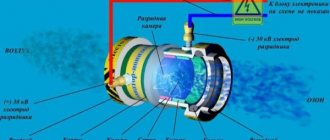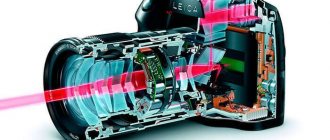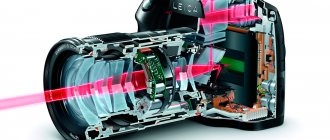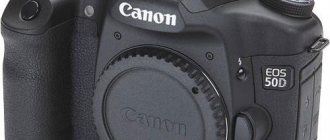Memory is an unreliable thing, so in order to preserve important moments for a long time, humanity has come up with various types of art of “capturing” reality. One of the most popular is still photography. Moreover, with the advent of almost every person having a smartphone, this type of art is becoming even closer.
However, professionals and many amateurs still advise using special photographic equipment: DSLR, mirrorless or compact to obtain high-quality results. How not to get lost in the variety of models offered and what is the difference between a DSLR, compact and mirrorless camera? How are these devices different? Find out in this review!
Before starting to get acquainted with various types of photographic equipment, it is worth making a special reservation. What exactly refers to a digital or SLR camera?
What is a digital SLR camera? These are compact SLR cameras that not only have a processor, like all digital ones, but also the presence of a special system of glass and mirrors.
A simple SLR camera with only mirrors can be electronic, or maybe film (for example, digital and analog cameras).
And now in more detail about the principles, pros and cons of each camera.
Camera design
What you can immediately pay attention to when comparing a regular DSLR and a compact is the dimensions, so the first difference between a DSLR and a digital camera is immediately visible. Due to the complexity of the system, a DSLR camera looks and weighs much heavier than a compact camera.
And, in addition, the lens adds weight to a SLR camera. A compact camera does not have the ability to change eyepieces, so the mass of the compact “out of the box” will be its final weight.
What types of cameras are there and how do they differ?
System cameras and their main characteristics
System cameras for photography are cameras that have a modular design. With this design, replaceable components of the device, such as lenses, cassettes, viewfinders, and flash, are installed on the device body. System cameras can be either DSLR or mirrorless.
Let's review the characteristics of mirrorless system devices. The viewfinders of this type of device do not use a mirror, since the viewfinders themselves are electronic.
The advantages of such devices include:
- small dimensions. This type of camera has compact dimensions and low weight due to its design;
- equipping cameras with various configuration tools and built-in functions that expand the capabilities of these devices;
- electronic viewfinder in the form of a small screen that allows for quick, easy adjustments.
Disadvantages of mirrorless cameras:
- the speed of switching on and starting operation of the device is lower than that of mirror models;
- focus delay;
- Devices of this type are inferior to mirror-type devices in terms of image quality.
The best representatives of mirrorless system devices for photography include the following representatives:
- Fuji model X-T10 is a fairly budget camera that is not inferior in frame quality to more expensive representatives of this type of device;
- Olympus OMDE-M10 II series. This series and model of mirrorless devices from this manufacturer have become widespread among amateur photographers due to their functionality and quality;
- Sony A7 II series is an excellent device that received the title of best system camera of 2021 due to its excellent image quality, wide range of functions, and additional features;
- Panasonic model LumixG. This device has earned user recognition thanks to its user-friendly interface, good image quality and OLED color viewfinder;
- Nikon 1J series. A mirrorless camera for beginner amateur photographers for whom the capabilities of a conventional digital camera are no longer enough.
DSLR and mirrorless system cameras, a review and comparison of the functions of which showed that both types of cameras allow you to create various unique images. However, the opinions of users are divided and each type of system device has its own connoisseurs. Thus, SLR cameras are most often used for shooting by professional photographers, as they make it possible to create photographs of the highest quality. Thanks to their high productivity and speed of operation, mirror-type devices allow you to photograph sporting events, various competitions, and various kinds of celebrations. Mirrorless system devices have become widespread among photography and outdoor enthusiasts due to their compact design. This type of camera is suitable for both beginners and advanced amateur photographers.
If you are a beginner amateur photographer and don’t know whether a system camera or an SLR is better to choose. What is the difference between the representatives of these devices, which camera is better to purchase at the initial stage, then you need to familiarize yourself with the material presented in this article. Here we will look at the difference between a system camera and a DSLR. What models are on the market today.
Reflex camera
What is a SLR camera? The first type of cameras is more complex due to its multi-component nature and operating principle. A DSLR also has more functions and modes than a simple compact. DSLR cameras have many lenses inside them, so a significant disadvantage from DSLR devices immediately appears - such a camera cannot be dropped and is better carried in a special bag or case.
The DSLR consists of two parts: Body or body, body plus kit lens. What does this mean among photographers? The body is the body itself, which contains all the glass and hardware, and the other half is the removable eyepieces.
As standard, all models come with a fairly ordinary lens, with which you can still get very good pictures. Their quality is far superior to a simple system unit.
Important! If you want to practice photography as an art, shoot distant or moving objects, nature, or turn to portrait photography, you will need to purchase different lenses: portrait, wide-angle, lens with a good zoom (increase), etc.
Inside the lens itself, unlike a digital camera, you can see lenses standing in a row and a diaphragm - a special plate that controls the amount of light falling on the matrix. Noise and color reproduction, and the overall quality of the entire photograph, depend on a properly functioning aperture.
An image using a SLR camera is obtained as follows:
- Light passes through the lenses.
- Then it hits the diaphragm.
- After the diaphragm, it floods the translucent mirror, dividing into two light beams. The first one is sent through rows of mirrors and passes a convex lens.
- The next stage is the pentaprism, where the light beam splits into an image and goes into the viewfinder. There the picture is already in the correct form, not upside down. And we see the result that we want to get by controlling photographic equipment.
- The second beam of light goes into a focusing system built on electronic sensors. They calculate whether an object is in focus. If not, then the lenses begin to shift a few degrees to make the image clear and “catch” focus.
- At the very end, when these two parallel processes come together and the photographer is satisfied with the image in the viewfinder, it’s time to press the shutter button. After which the mirror system moves aside, and the light completely falls on the matrix, fixing the desired image on it. Photo is ready!
Advantages of system technology
- the camera is well equipped with functionality that allows you to quickly set up and get other advantages of shooting;
- insignificant parameters, light weight.
- The viewfinder consists of a compact screen that makes it easy to enter into the design.
In addition to the positive aspects, the system camera has disadvantages:
- the equipment does not turn on immediately, you need to wait a little;
- focusing works late;
- The image quality is inferior to images taken using a DSLR camera.
Compact camera
What is the difference between a system camera and a DSLR? The design of a compact, unlike a DSLR, is much simpler. This is a unit with a one-piece body and a built-in lens.
The principle of operation and image acquisition is the same as that of a SLR camera, there is no difference here. However, light passing through a set of lenses is not separated into the viewfinder and the foam prism. The light immediately hits the matrix, and after processing the image by the processor, a photo comes out.
In fact, the photographer here is the equipment itself, and the owner of the compact is the customer who needs a specific object in the photograph.
Therefore, the disadvantage of a compact unit is that the processor processes the image in its own way, not allowing you to change the final result, which is easily possible in a DSLR.
Digital cameras are also divided into several classes based on the principle of applicability. There are reporter, studio, panoramic, etc. soap dishes.
These cameras have a built-in flash, and there are several standard modes, for example, conventionally called portrait, landscape, and macro photography.
The soap dish saves its files in JPEG format, unlike a DSLR, which creates a raster image when shooting. Why is a mirror device better at this point? A raster image is a picture, which is then very convenient for professional designers to develop in Photoshop. A digital camera does not have this privilege.
However, the following interesting “gadgets” can be found in system cameras:
- Interchangeable attachments for an already built-in lens, for example, to create a “semblance” of a wide-angle image.
- "Hot shoe" This is a special plate at the top of the compact where you can attach a removable flash or image stabilizer to make the photo as clear as possible.
- Manual focus. A relatively new thing, since the focus is still controlled by the processor itself. What's better? Determined by the owner of the equipment himself.
- Powered by any batteries. It's not always convenient to have a battery, which suddenly happens! and discharged. Standard AA batteries are sold everywhere, and the problem can be solved very quickly. This is where the digital camera compares favorably with other cameras. With a DSLR camera, this can be solved in an instant only with a special spare battery.
DSLR device
In a SLR camera, the mirror located closer to the shutter and directly connected to the eyepiece is of great importance. The signal arriving at the mirror is reflected and hits the ground glass, collecting lens and pentaprism. Only after this we see the image through the visor.
Thanks to a complex device, an initially blurry and inverted picture can be observed as normal, corresponding to reality.
Such a viewfinder is called a mirror viewfinder, just like the device itself. I think it has become obvious that DSLRs are complex in design and can be an order of magnitude more expensive than other models. Note that we only touched on one detail in DSLRs!
Differences in the design of compacts and DSLRs
DSLR or compact? In addition to the obvious differences in operating principles, a DSLR camera differs from a regular compact camera in focusing functionality. A SLR camera has an optical focus, as optics work - a system of mirrors and lenses. Compacts are electronic; the focus is monitored by a processor. This is why compacts are often popularly called “point-and-shoots,” because due to the automatic focus, the processor sometimes likes to “blur” images, making them unclear.
Functionality of compacts and DSLRs
Compact fans always argue with DSLR fans about functionality. What is the difference? Here it is important to consider the main thing - for what purpose does a person take photographic equipment? If you need a simple device that works on the principle: “click” - “here is a photo,” then a compact is the best option.
No need to bother with settings, know the basics of photography, etc. For a point-and-shoot camera, the most important thing is to capture the desired frame with little loss. Yes, the image may have noise and may be slightly blurred, but this is not critical, however, a photo for memory is taken extremely quickly. You can quickly zoom in or out on an object, as well as use several filters after shooting with the camera.
So, SLR and digital...
DSLR models are much more than just a camera. It is no coincidence that the camera is called a SLR, that is, the best reflector. These cameras offer a lot more room for experimentation than digital ones, especially in manual mode. Changing the focus, changing the shutter speed, adjusting the aperture time is easy!
Only for this you need to understand the instructions well and learn the basics of photography. For beginners, there is on-site practice - an automatic mode that will help you learn everything in the field.
Thanks to better focusing, the DSLR camera offers clear continuous shooting and panoramas without loss of quality. And, of course, color rendering... DSLR cameras even have interchangeable filters to play with color and make the end result a real work of art.
Advantages:
- Convenience, ergonomics similar to a SLR camera
- Excellent build quality; Splash and dust resistant magnesium alloy body
- Superior image quality and high ISO performance for Micro Four Thirds
- Amazing dynamic range for its class, improved over its predecessor
- Very fast autofocus
- Minimum shutter lag
- High continuous shooting speed (~ 12 fps at full resolution)
- Deep buffer for JPEG
- Good RAW buffer depth (although may vary with card type)
- Many options for in-camera image processing (noise reduction, saturation, contrast, etc.)
- Battery endurance is above average for a system camera (CSC)
- Good flash range (17m at ISO200)
- The shutter life is designed for 200,000 cycles
- Electronic shutter option
- Bright and easy to read electronic viewfinder (EVF)
- Touch-sensitive, clear, high-resolution vari-angle OLED display that is easy to read in bright sunlight
- Built-in flash
- Built-in Wi-Fi and NFC module
- Many elements for physical control and parameter settings
- Mode switch lock
- Record 4K video in modes: Cinema 4K (4096x2160) and Ultra HD/4K (3840x2160)
- Very high video quality with excellent detail, color reproduction and dynamic range
- High video bitrate (100 Mbit/s for 4K, up to 200 Mbit/s for Full HD)
- Professional-grade video features
- Minimal rolling shutter effect at 1080/60p and 30p video (small rolling shutter effect at 1080/24p)
- Variable video frame rate: slo-mo and semi-timelapse (96 fps and less up to 2 fps in 1080p resolution)
- Pure HDMI output, 4:2:2, 8-bit or 10-bit











